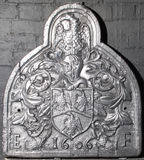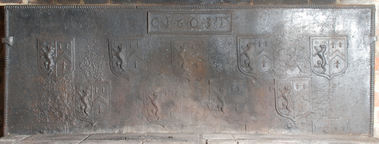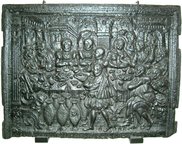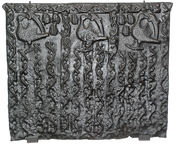-
583
Description: Arch-shaped, with rounded-arched extension at top; cavetto moulded edge all round; five vertical planklines; arms of the Francis (or Franceis) family of Derbyshire: Argent a Chevron gules between three Eagles displayed of the same; Crest: an eagle displayed on a crowned knight’s helm; initials in bottom corners; date below shield.
Notes: Probably the arms of Sir Edward Francis, who was Seneschal of the Petworth House estate and took overall charge in 1606 when the 9th Earl of Northumberland was committed to the Tower of London for his alledged involvement in the Gunpowder Plot.
Copies of this fireback are known.
Inscription: E 1606 F
Arms: Sir Edward Francis
- Decoration tags:
- arched with arch above (shape)
- cavetto (edging)
- whole carved pattern
- planklines
- armorial
- text
Manufactured: in 1606 probably at Frith Furnace, Northchapel in the Weald area of England.
Current location: Petworth House, Petworth, West Sussex, England.
Museum number: NT/PET/M/41.1 (part of the National Trust museum group)
Citation: Gardner, J. S., 1898, 'Iron Casting in the Weald', Archaeologia, 56, 1, pp. 133-164.
- Attached to series:
- Personal armorial firebacks
-
665
Description: Rectangular; twisted rope edging (probably on on top and sides only); cavetto-moulded-edged rectangle top centre, enclosing date between initials; 14 shields of Ayloffe impaling Sulyard in three rows (5-4-5).
Notes: Ayloffe: sable, a lion rampant Or, collared gules, between three crosses formy of the second; Sulyard: argent, a chevron gules between three pheons inverted sable. William Ayloffe (c1535-1584) of Bretons, Hornchurch, Essex, Justice of the Court of Queen’s Bench, married (c1560) Jane, dau. of Sir Eustace Sulyard, of Runwell, Essex. There is a large number of variants using the same shields. The bottom part of the fireback is obscured in the photograph. The initials 'CT' are likely to be those of Charles Tyler, a founder whose working life and that of his family have strong parallels with the occurrence of these firebacks.
Inscription: C.1.6.0.3.T
Arms: Ayloffe impaling Sulyard (William Ayloffe of Bretons, Hornchurch)
- Decoration tags:
- rectangular (shape)
- rope (edging)
- carved stamps
- individual letters
- individual numbers
- armorial
- text
Manufactured: in 1603 possibly at Bedgebury Furnace, Goudhurst in the Weald area of England.
Current location: in private hands, Rolvenden, Kent, England.
Citation: Gardner, J. S., 1898, 'Iron Casting in the Weald', Archaeologia, 56, 1, pp. 133-164.
- Attached to series:
- Ayloffe series
- Personal armorial firebacks
-
731
Description: Rectangular with flanged edging and a moulded frame; pictorial scene of the Marriage at Cana in an architectural setting; inscription along bottom edge.
Notes: The pattern-maker is believed to be Master Ronnung.
Inscription: HISTORIA VON DER HOCHZEIT ZV CANA IN GALILEA ...
- Decoration tags:
- rectangular (shape)
- flanged (edging)
- whole carved pattern
- pictorial
- biblical
- text
- humans
- objects
Manufactured: in the late-16th century possibly in the Harz area of Germany.
Current location: Victoria & Albert Museum, Cromwell Road, Kensington & Chelsea, Greater London, England.
Museum number: 319.1897 (part of the Victoria & Albert Museum museum group)
Citation: Dawson, C., 1903, 'Sussex Iron Work and Pottery', Sussex Archaeological Collections, 46, pp. 1-54.
Citation: Gardner, J. S., 1898, 'Iron Casting in the Weald', Archaeologia, 56, 1, pp. 133-164.
- Attached to series:
- Stoveplates
- Marriage at Cana stoveplates
-
735
Description: Rectangular; three birds (probably swans, a Lancastrian badge) turned to the left, their heads facing right, and the front edge of their left wing extended and inverted; vine pattern strips, one horizontal along the top, and 14, of varied length, vertically across the rest of the fireback; seven ‘grape bunch’ shapes with criss-cross markings, arranged in three groups — 3-1-3 — adjacent to the birds.
Notes: The same vine strips are found on several firebacks, including some of the ‘Anne Forster’ series; the birds are also seen on a number of firebacks; the ‘grape bunch’ shapes may be the same as those on the ‘Anne Forster’ graveslab in Crowhurst church, Surrey. John Starkie Gardner and later writers attributed the birds to an association with the Fowle family; this is unlikely to be correct as the Fowles came to prominence in the iron industry towards the end of the sixteenth century and had their own distinctive decorative emblems. Formerly in the collection of Lady Dorothy Nevill.
- Decoration tags:
- rectangular (shape)
- complex, furniture-derived (edging)
- simple stamps
- carved stamps
- animals
- objects
Manufactured: in the mid- to late-16th century possibly at Pounsley Furnace, Framfield in the Weald area of England.
Current location: Victoria & Albert Museum, Cromwell Road, Kensington & Chelsea, Greater London, England.
Museum number: M.120-1914 (part of the Victoria & Albert Museum museum group)
Citation: Dawson, C., 1903, 'Sussex Iron Work and Pottery', Sussex Archaeological Collections, 46, pp. 1-54.
Citation: Gardner, J. S., 1898, 'Iron Casting in the Weald', Archaeologia, 56, 1, pp. 133-164.
Citation: Straker, E., 1931, Wealden Iron (London, Bell).
- Attached to series:
- Pounsley series
- Vine strip series
- Swan series
- Furniture stamp firebacks
-
737
Description: Armorial within complex ovolo moulded edging on all sides; two plank lines; the achievement is distinguished by the elaborately festooned mantling, the whole resting on a boat-shaped compartment.
Notes: The arms are of an esquire, and the crest - on a chapeau a wyvern, wings elevated and tail nowed, ducally gorged - matches that of the Trevor family. The shield is probably of impaled arms, i.e. those of a husband on the left and wife on the right. The husband's arms include several quarters with lions rampant, which were often a feature of the arms of Welsh families (of which the Trevors were one). The first quarter of the wife's arms is also of a wyvern, but the arms as a whole have not be identified. They have been variously, but incorrectly, attributed to John Trevor who married Elizabeth Morley, née Clarke, to Lord Dacre (a descendant of John Trevor), and to Col. Marcus Trevor, 1st Viscount Dungannon (peers' arms have supporters). The distinctive shape is seen in similar form on several other armorial firebacks from the mid-16th to 17th centuries, suggesting a continuity of pattern making, if not the same pattern maker. Many copies of this fireback exist.
Copies of this fireback are known.
Arms: Trevor
- Decoration tags:
- complex quasi-arched (shape)
- ovolo (edging)
- whole carved pattern
- planklines
- armorial
Manufactured: in the mid- to late-17th century in the Weald area of England.
Current location: Victoria & Albert Museum, Cromwell Road, Kensington & Chelsea, Greater London, England.
Museum number: 142.1892 (part of the Victoria & Albert Museum museum group)
Citation: Gardner, J. S., 1898, 'Iron Casting in the Weald', Archaeologia, 56, 1, pp. 133-164.
- Attached to series:
- Ornate border series
- Personal armorial firebacks
- Welsh armorial firebacks
-
300
Description: Arched rectangular shaped central panel with bead-and-pellet edging on a broad fillet; Jupiter in his chariot drawn by eagles; above are clouds, below is a landscape; arched rectangular shaped border with fillet edging, with a symmetrical scrolled wire design; the monogram, SHR, bottom centre; above is a symmetrical design of scrolled floral tendrils.
Notes: The design is derived from a personification of the planet, Jupiter, in 'Planetarum effectus et eorum in signis zodiaci', by Marten de Vos (1585). Two editions of engravings of de Vos's drawings are known, by Jan Sadeler, dated 1585, and by Gregor Fentzel in about 1650.
Copies of this fireback are known.
Inscription: SHR
- Decoration tags:
- 'Dutch' (shape)
- fillet (edging)
- whole carved pattern
- pictorial
- mythological
- monogram
- animals
- humans
- objects
Manufactured: in the late-17th to early-18th century in England.
Current location: Powis Castle, Welshpool, Powys, Wales.
Museum number: 1180886 (part of the National Trust museum group)
Citation: Dawson, C., 1903, 'Sussex Iron Work and Pottery', Sussex Archaeological Collections, 46, pp. 1-54.
Citation: Gardner, J. S., 1898, 'Iron Casting in the Weald', Archaeologia, 56, 1, pp. 133-164.
- Attached to series:
- SHR series
- British 'Dutch' style firebacks
- De Vos Planets series





